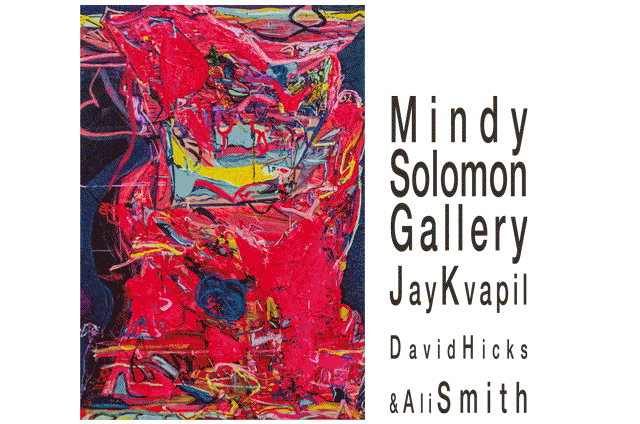“A Taste for Plums” David Hicks & Ali Smith,
Jay Kvapil: “Mimesis”, Mindy Solomon Gallery, 2019
Group Exhibition
I find it interesting that I am so often drawn to the work of California artists. Is it because of the light? The vegetation? Perhaps it is the magic of Hollywood, fields of vines, giant, majestic redwoods, or being one of the epicenters of political and social change. I suppose the real reason is the quality of the work.

Ali Smith and David Hicks both live in California. Educated at California State University Long Beach, David was and undergraduate while Ali was pursuing her Master of Fine Arts degree in painting. Like ships passing in the night, neither would know until much later that they would find themselves exhibiting together on the other side of the country. Ali Smith writes about her current body of work:
“My new paintings are a culmination of several years of working in a slow, deliberate manner, often creating vast layers of paint that build up over time. Evoking multi-layered maps, wastelands or invented landscapes, I use intuitive doodles, ornamentation and dramatic scale shifts to lure the viewer in. Each painting holds together as a complex unit, simultaneously built, constructed, woven or erased, to create a complex, abstract language.”
Using vivid color and a hybrid language of painting, I often merge drawing and painting; a more sculptural slab of paint might reside in the same space as a quickly drawn line. Within my work, I am attempting to sort through the visual and cultural clutter I encounter on a daily basis, and make something meaningful from it. I tend to work in groups of paintings rather than series, where each painting might have a very different identity from the next, almost like a single song on an album, and each individual painting has its own set of rules.
While I draw on a broad range of references, I have long been interested in the question of what it means to be a female painter employing the language of abstraction, and how one might challenge and bring a sense of invention to current painting.”
David Hicks also ponders the real and invented in his works.
“In coming to an explanation of where my art originates in my studio process; I personally struggle. It is not an easy process for me formulate a written response about my work. Over the years I have found it increasingly difficult to opine about the romance of the studio and come to some poignant collection of words that defines why I do what I do. I am an echo of my surroundings. My concepts of beauty are defined by my daily journey. In order to explain I’ve created a small poem called Directions Home.”
Take a left at the Almond orchard. Drive for two miles
Keep going past the water reservoir and you’ll see the crops change to Corn,
get ready to turn. Hang a right at the giant stack of hay bails.
7 miles of Cornfields and Cow Dairies, then you’ll hit the Freeway into Visalia.
Almost home.
Inspired by light and life, Ali Smith and David Hicks’ exhibition will create a sense of place while igniting the imagination.
web site of artist David Hicks
Mimesis
MIMESIS: The imitative representation of nature and human behavior in art and literature
-Vocabulary.com
Mindy Solomon is pleased to present the first solo exhibition in Miami of California artist Jay Kvapil.

Inspired by topography, Jay creates surfaces that can only be achieved after years of making. Dedicated to hard work as both an artist and University educator, the fruits of his labor are clearly evident in his oeuvre. Kvapil writes: “Most of the recent pieces allude to landscape, intentionally so. After all, I grew up in Arizona, which is a land of vast desert landscapes, but it is also rich in intimate pictorial spaces found in small rocks and stones. Some of the pieces have an obvious horizon line, giving them a distant landscape, while others depict an intimate landscape through which we travel – whether literally or in our minds –without a specific reference.
In the end, what I make is pottery just pottery. I’m not interested in calling it ceramic art or sculptural ceramics. It’s pottery, plain and simple, because that is the language that it speaks and the history from which it comes, and to whom it speaks. If my work is successful, I like to think that it is kind of conversation with potters that came before me, and the ones who will come after.“
Trained as a master potter in Japan, Kvapil also finds inspiration in the simple elegant forms that were emblematic of the mid-century modern period. Artists like James Lovera, and Gertrud and Otto Natzler paved the way with their beautifully articulated minimalist vessels and volcanic surfaces. Kvapil’s works are an homage to the genre and continue to prove that good design is timeless.
Informed by geographical surfaces, modernist design, Japanese pottery and the alchemy of his glaze confections, Jay Kvapil brings high craft and contemporary art together.
